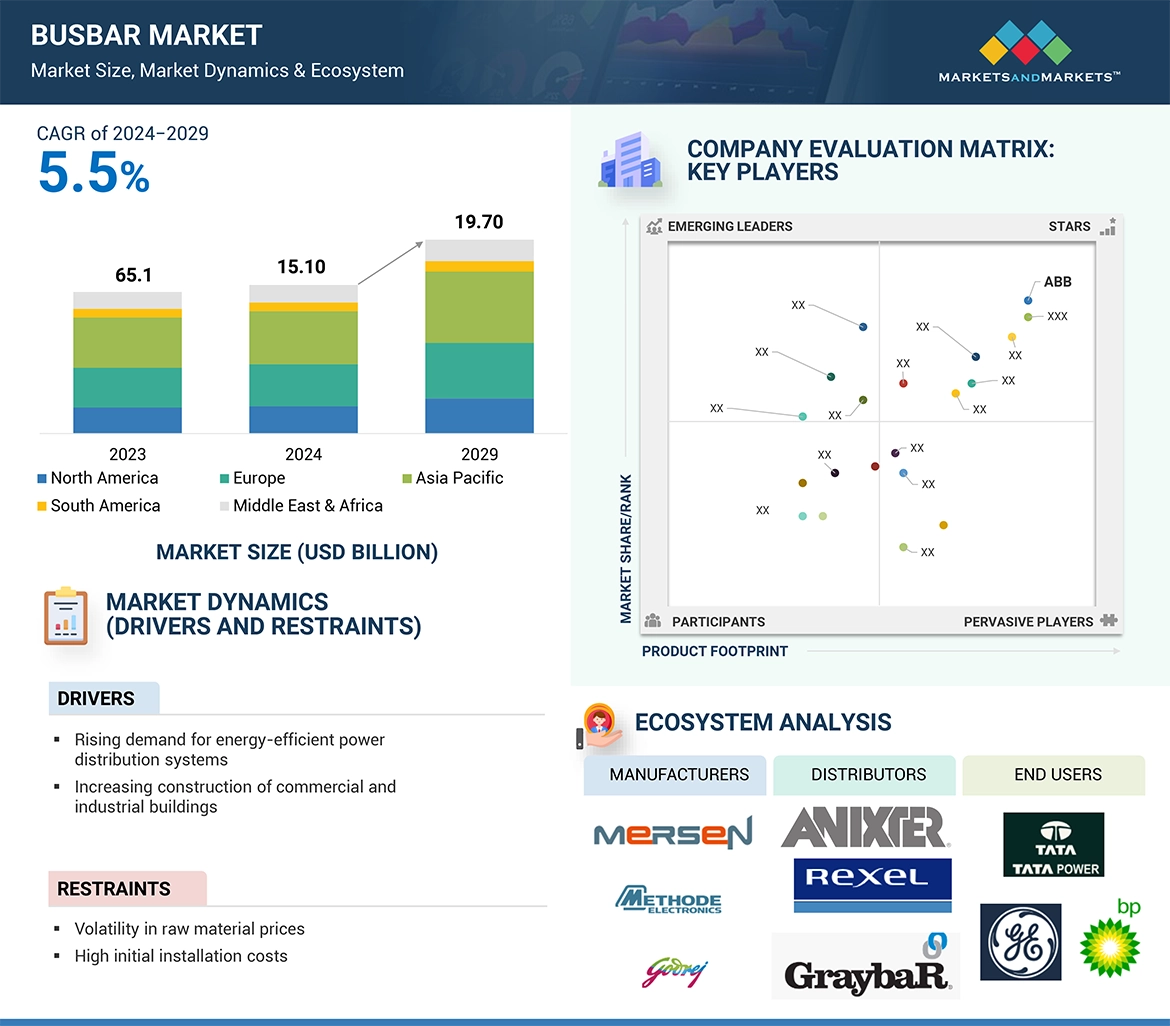According to a research report “Busbar Market by Material (Copper, Aluminum), Power Rating (Below 125 A, 125-800 A, Above 800 A), Insulation (Laminated, Powder-coated, Bare), Manufacturing Process (Molded, Stamped, Hybrid, Flexible), End-use and Region – Global Forecast to 2029″ published by MarketsandMarkets, the global busbar market is expected to grow very rapidly, from an estimated USD 15.10 billion in 2024 to USD 19.70 billion by 2029 at a CAGR of 5.5% over the forecast period. These factors are largely influenced by the rising needs for efficient power distribution systems in industries such as utilities, automotive, and industrial sectors because of increasing electrification and infrastructure development. The growth of the busbar market is also seen to be driven by government policies on encouraging a shift to renewable sources and grid modernization. Those busbars with digital technologies like automation, sensors, and data analytics have improved the processes involved in manufacturing and operating busbars while cutting energy consumption, and material wastage, and increasing efficiency. These developments have reduced costs, improved reliability, and made busbar systems more sustainable, further propelling growth in this market.
Download PDF Brochure: https://www.marketsandmarkets.com/pdfdownloadNew.asp?id=181939364
Laminated busbars, by insulation, is expected to be the fastest-growing market during the forecast period
Laminated busbars, depending on insulation type, is likely to account for maximum market share during the forecast period due to its superior electrical and mechanical properties. This type of busbar involves the use of several very thin layers of conductors like copper or aluminum with the laminating insulating materials that reduce inductance values and hence minimize electrical losses and maximize heat dissipation. It increases the overall performance of power distribution systems, especially for high-current applications. And thus, laminated busbars are chosen by industries that involve electric vehicles, renewable energy, and data centers. Not to mention, they display astounding properties that bring down electromagnetic interference, which even makes them the go-to application for high precision and efficiency requirements. This will continue to allow for growth in the entire laminated busbar market with the fast-approaching trend toward electrification and further need for advanced power management solutions in the industrial and renewable sectors.

Copper, by material, is expected to be the largest-growing segment during the forecast period.
Copper is expected to represent the largest-growing material segment by in the busbar market in the forecast period due to its superior electrical conductivity, thermal performance, and durability. Copper busbars have the excellent ability to carry current and are therefore demanded wherever high conduction efficiency is required in the power distribution. For practical applications such as utilities, renewable energy, industrial machinery, and automotive industries, these busbars are in demand because of their capability to conduct higher current densities while minimizing losses in power. The recyclable properties combined with the lack of corrosion to copper increase this material’s appeal, especially as more and more industries have sustainability at their forefront. Copper busbars enjoy the high end in market dominance mainly due to trends in electrification and increased requirements for dependable and efficient solutions. Highly dependence on copper busbars is dominated by a various application in high performance environments such as electric vehicles, power distribution networks, and data centers that focus a lot on power efficiency.
Asia Pacific is expected to be the largest region during the forecast period.
Asia Pacific is expected to maintain a leading position over the forecasting years, given its accelerated industrialization, urbanization, and infrastructure development. Emerging countries like China, India, and Japan are all part of the emerging nation that boosts the country’s energy demands, hence prompting stiff growth in the capacity of power generation systems. In addition, most governments in the region have invested in upscaling the standards of the electrical grid, which has become a means of ensuring efficient transmission and transformation of power. The Asia Pacific region has seen growth in the automotive and electronics industries, which means that the demand for efficient power distribution systems increases, thereby contributing to the growth of the busbar market in that region.
Make an Inquiry: https://www.marketsandmarkets.com/Enquiry_Before_BuyingNew.asp?id=181939364
Key Players
Some of the major players across the globe in this busbar market are ABB (Switzerland), Siemens (Germany), Schneider Electric (France), Eaton (Ireland), and Mersen (France). These companies have aggressively embraced various strategies to enhance their presence and respond to the increasing demand for efficient power distribution systems. Key strategic steps include the development of new products for advanced busbar technology, a strategic acquisition that broadens the present product offerings, and partnerships that expand their reach into newer markets.
